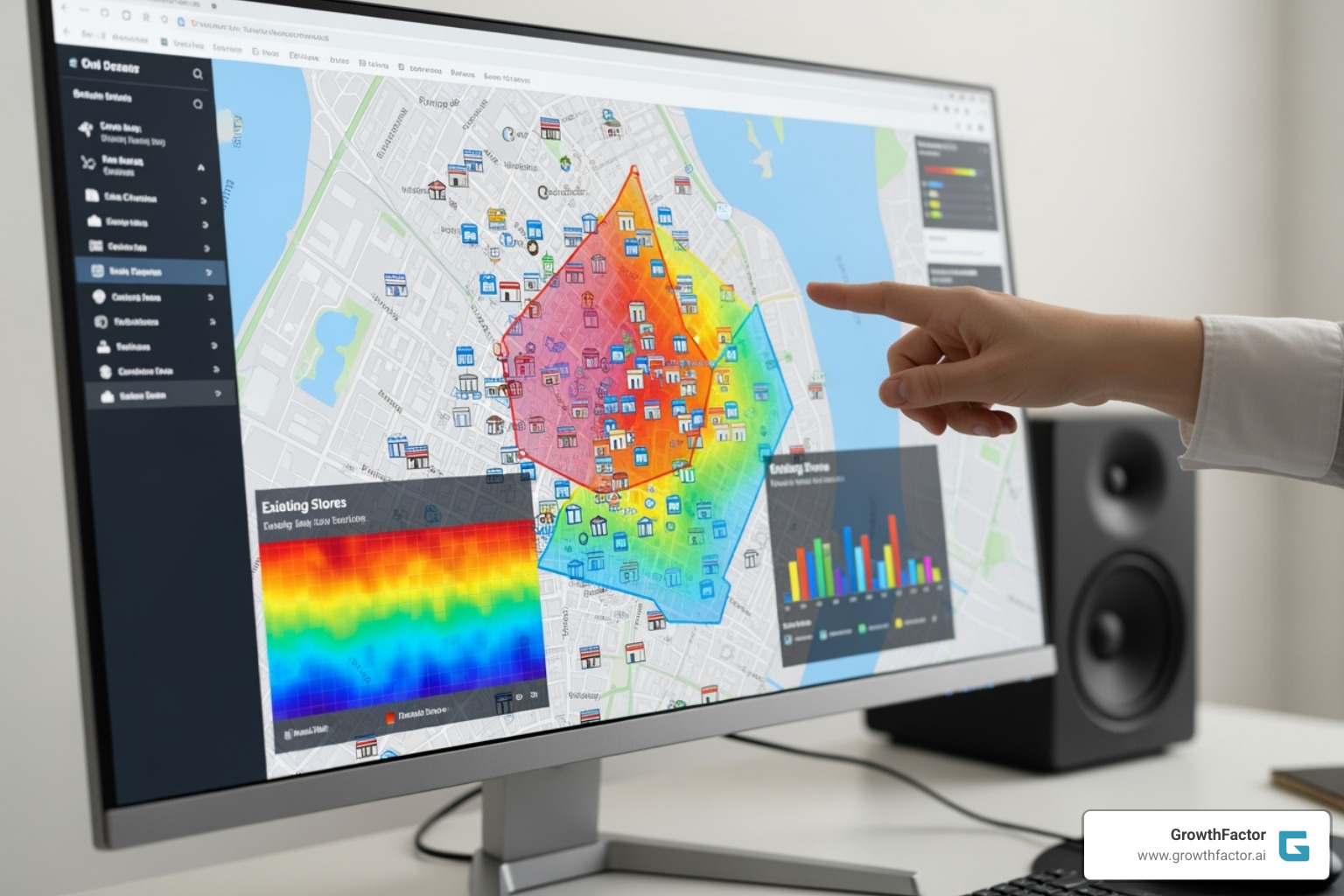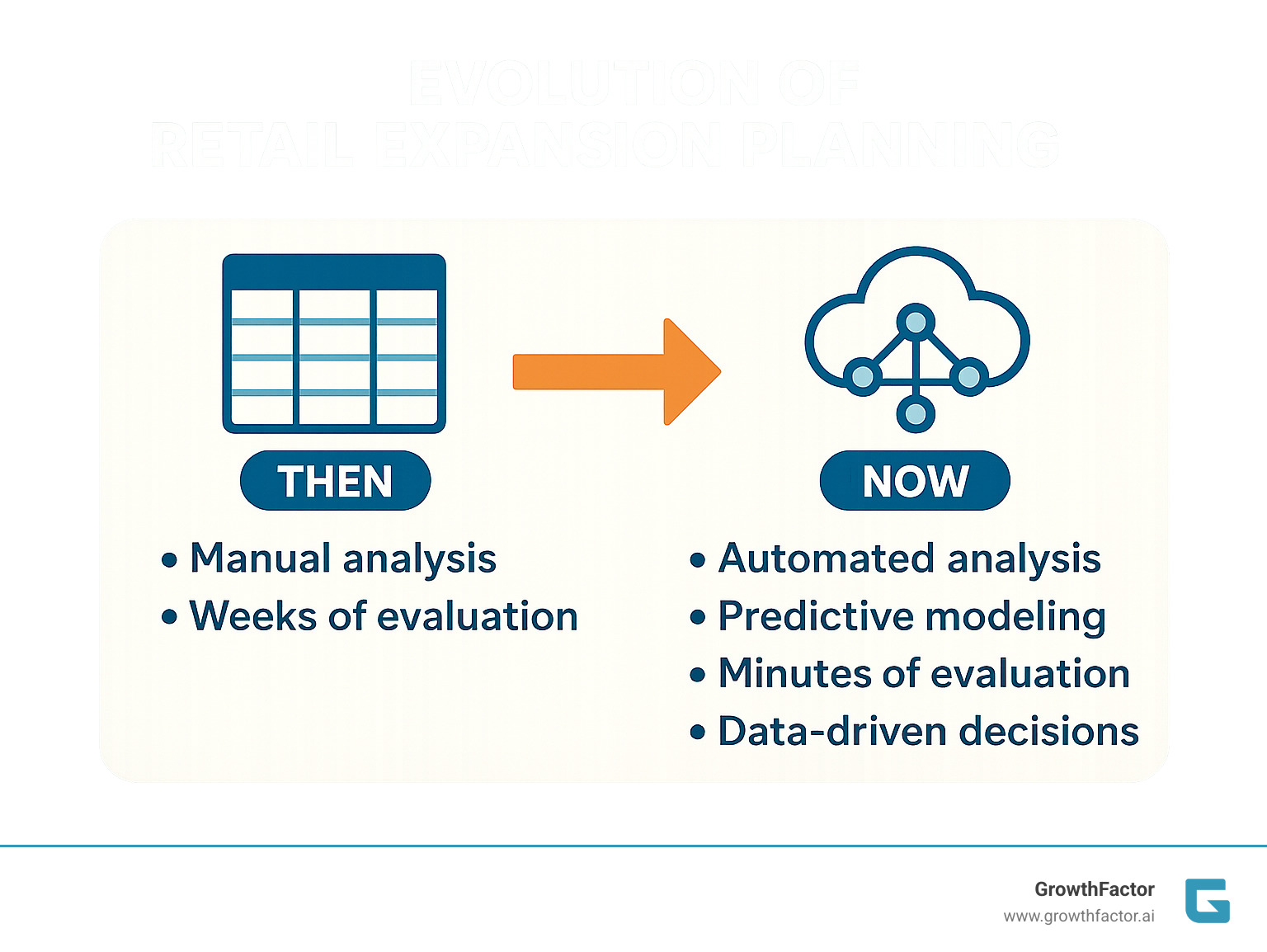Retail Expansion Made Easy—Software Solutions That Actually Work
Written by: Clyde Christian Anderson
Why Smart Retailers Are Ditching Spreadsheets for Software

Retail expansion planning software is changing how growing chains identify, evaluate, and secure new store locations. These AI-powered platforms combine market analysis, predictive forecasting, and financial modeling to help retailers make data-driven expansion decisions faster and more accurately than traditional manual methods.
Top retail expansion planning software features include:
- Geospatial analysis - GIS mapping, demographic overlays, and trade area delineation
- Predictive analytics - Sales forecasting, cannibalization modeling, and performance prediction
- Financial modeling - ROI calculations, lease management, and portfolio optimization
- Workflow automation - Deal tracking, automated reporting, and team collaboration tools
- AI-powered insights - Real-time data processing and scenario modeling
The retail landscape is brutal. With 7,327 store closures in 2024—a 57.8% increase from the previous year—making the wrong location decision can be catastrophic. Yet most retailers still rely on outdated spreadsheets and gut instincts to make million-dollar site selection choices.
The old way doesn't work anymore. Manual site evaluation takes 15-30 minutes per location just to screen out obvious mismatches, and several hours for serious contenders. For a retailer evaluating 800 potential sites during a bankruptcy auction, that's over 510 hours of work—more than 12 full-time weeks.
Modern retail expansion planning software changes this completely. What used to take weeks now happens in minutes. Advanced platforms can evaluate multiple sites simultaneously, build committee-ready reports, and provide sales forecasts with 90% confidence levels.
The shift from manual to automated planning isn't just about speed—it's about survival. Retailers using data-driven expansion software are securing prime locations before competitors even finish their initial analysis. They're making better decisions with less risk and opening profitable stores faster.
I'm Clyde Christian Anderson, CEO of GrowthFactor.ai, where I've helped retailers like Cavender's Western Wear evaluate 800+ locations in under 72 hours during major bankruptcy auctions. My background in retail real estate and investment banking gives me unique insight into how retail expansion planning software is revolutionizing the industry.

What is Retail Expansion Planning Software and What Does It Do?
Retail expansion planning software is your digital command center for growing your retail business strategically. Instead of crossing your fingers and hoping that new location works out, this specialized platform gives you the data and insights to make confident expansion decisions.
Think of it as having a crystal ball—except this one actually works. Rather than relying on gut feelings or driving around neighborhoods hoping to spot the perfect storefront, the software analyzes mountains of data to show you exactly where your next store should go.
The primary purpose is simple: turn expansion guesswork into data-driven decisions. For decades, retailers have opened new locations based on intuition, basic demographic reports, and whatever felt right. That approach might have worked when competition was lighter and consumer behavior was more predictable. But in today's fast-moving retail world, those old methods are a recipe for expensive mistakes.
This software tackles the biggest headaches that keep expansion teams up at night. It helps you avoid those costly blunders like choosing a location that looks perfect on paper but tanks within six months. By pulling together everything from market analysis and competitive intelligence to financial forecasting and site selection data, it paints a complete picture of each potential opportunity.
The real magic happens in risk mitigation. Every new store represents a significant investment—often hundreds of thousands or millions of dollars. The software helps you understand not just whether a location might work, but how well it's likely to perform and what factors could impact its success. This dramatically improves your chances of opening profitable stores while avoiding the heartbreak of underperforming locations.
Beyond just picking good spots, these platforms support strategic growth planning. They help you figure out the right timing for expansion, choose between different growth strategies, and allocate resources effectively. Whether you're planning your second location or your 200th, the software scales with your ambitions.
For retailers ready to move beyond spreadsheet chaos and accept systematic growth, retail expansion planning becomes less stressful and more profitable. You can dive deeper into proven approaches with our comprehensive guide on retail store expansion strategy.
The bottom line? Retail expansion planning software transforms one of business's biggest gambles into a calculated, data-backed strategy. It's the difference between hoping your next store succeeds and knowing it will.
The Core Features of High-Impact Retail Expansion Planning Software
When you're looking at retail expansion planning software, you want to know what separates the game-changers from the glorified spreadsheets. The truth is, it's all about having the right combination of features working together seamlessly. Think of it like a Swiss Army knife for retail growth—every tool has its purpose, and together they create something far more powerful than the sum of their parts.
The best platforms serve as a centralized platform where all your expansion data lives and breathes. No more hunting through different systems or wondering if you're looking at the latest version of a report. Everything you need is right there, accessible through a user-friendly interface that doesn't require a computer science degree to steer. And here's the kicker—these systems grow with you. Whether you're planning your second location or your 200th, the scalability ensures your software won't become a bottleneck.

Geospatial & Market Analysis Tools
Picture this: instead of driving around neighborhoods with a notepad, you're looking at a detailed map that shows you exactly where your customers are, where your competitors are lurking, and where the golden opportunities are hiding. That's what GIS mapping brings to the table in modern retail expansion planning software.
These tools create stunning heat maps that light up with customer activity, showing you the hottest spots in your market. Layer on demographic data and you'll see age groups, income levels, and household sizes painted right onto your map. But it gets even better with psychographic analysis—understanding not just who your customers are, but what makes them tick, what they value, and how they shop.
Whitespace analysis is like having X-ray vision for untapped markets. The software spots those underserved areas where demand exists but competition is thin. Trade area delineation draws precise boundaries around where your customers actually come from—not where you think they come from. And with competitor tracking, you'll know exactly what the competition is up to before they even know it themselves.
For retailers serious about making data-driven decisions, this geographic intelligence is pure gold. You can dive deeper into this approach with our guide on data-driven site selection.
Predictive Analytics and Sales Forecasting
This is where retail expansion planning software gets really exciting. Forget about crossing your fingers and hoping for the best—AI-powered models can predict how a new location will perform with remarkable accuracy. These aren't just fancy calculators; they're sophisticated systems that crunch dozens of variables simultaneously.
Performance forecasting takes into account everything from local foot traffic patterns to seasonal shopping trends. The software analyzes customer behavior insights to predict not just how many people will visit, but how they'll shop and what they'll buy. Foot traffic analysis reveals the ebb and flow of potential customers throughout the day, week, and year.
Here's where it gets really smart: cannibalization modeling. When you open a new store, some sales might come from your existing locations nearby. The software calculates this impact precisely, helping you understand the true revenue potential of each site. This level of insight is what helped Guess Europe increase their operating margin from 5.6% to 12%—they could see the full picture before making their moves.
Financial Modeling & Portfolio Management
Money talks, and retail expansion planning software speaks its language fluently. Every expansion decision comes down to dollars and cents, and these platforms make sure you're counting them correctly. ROI calculation tools show you exactly what return you can expect from each potential location, helping you prioritize opportunities that offer the biggest bang for your buck.
Cost management features track everything from initial setup costs to ongoing expenses. Lease administration keeps all your property agreements organized and alerts you to important dates and renewal opportunities. Capital investment planning helps you budget for the long term, ensuring you're not caught off guard by unexpected expenses.
Portfolio optimization is where the magic happens for multi-location retailers. The software looks at your entire network of stores and suggests improvements—maybe relocating an underperforming location or identifying markets where you need more coverage. Schnuck Markets saves $780,000 per year per store manager using these integrated planning solutions, proving that smart financial management pays for itself many times over.
Want to understand the complete process? Check out our detailed guide on the retail site selection process.
Workflow Automation & Collaboration
Opening a new store involves more moving parts than a Swiss watch, and keeping everyone in sync can feel like herding cats. That's where workflow automation becomes your best friend. Retail expansion planning software creates a centralized data hub where everyone works from the same information—no more version control nightmares or missed communications.
Deal pipeline tracking follows each potential location from initial find through lease signing and grand opening. You'll know exactly where each deal stands and what needs to happen next. Automated reporting means less time creating PowerPoints and more time analyzing opportunities. The software generates committee-ready reports that make decision-making faster and more confident.
Site approval workflows streamline the entire approval process, with clear stages and accountability. No more chasing down signatures or wondering if someone dropped the ball. Team collaboration tools break down silos between departments, ensuring your real estate team, finance department, and operations group are all pulling in the same direction.
This level of integration transforms how teams work together. As one of our customers put it, their system became "the center of our IT universe"—everything flows through it, and everyone benefits from the improved visibility and efficiency.
If you're ready to see how this can work for your expansion team, explore our solutions for expansion managers.
The Power of AI and Advanced Analytics in Modern Expansion
When we talk about modern retail expansion planning software, we're not just talking about glorified spreadsheets anymore. We're talking about the transformative power of Artificial Intelligence (AI) and advanced analytics. This isn't just a buzzword; it's a fundamental shift in how we approach growth.
Think of AI as your incredibly smart assistant who never sleeps and processes information at superhuman speed. Unlike traditional business intelligence tools that simply tell you what happened last month, AI-powered retail expansion planning software goes much further. It's moving beyond BI to provide predictive insights about what will happen next and prescriptive recommendations for what you should do about it.
Imagine having a system that can tell you with 90% confidence which location a competitor will pick next, down to the exact real estate parcel. That's the kind of power we're talking about. AI excels at real-time data processing, constantly ingesting billions of mobile pings, traffic counts, and parcel data to paint an up-to-the-minute picture of any market you're considering.
One of the most valuable capabilities is scenario modeling. Want to know what happens if you open three stores in Phoenix instead of two? Or how a new competitor moving into your trade area might affect sales? AI can run these "what if" situations instantly, letting you understand the potential impact before making real-world commitments.
But here's where it gets really exciting: AI can spot hidden market patterns that even experienced analysts might miss. It might notice that foot traffic increases by 15% near certain types of businesses, or that demographic shifts in specific neighborhoods predict higher sales for your category. These subtle insights can be the difference between a home run location and a strikeout.
This translates into real agility for your expansion team. Instead of spending weeks manually evaluating potential sites, you can now process five times more locations efficiently. Faster evaluation means you can respond to market opportunities before competitors even know they exist. Our AI Agent Waldo, for instance, helps teams achieve exactly this kind of speed and accuracy.
The result? You're no longer reactive, waiting for the perfect site to fall into your lap. You're proactive, identifying opportunities before others see them and making confident decisions based on data rather than hunches. For a deeper dive into this revolution, check out More info on how AI is revolutionizing retail site selection.
How Software Drives Profitability and Supports Different Growth Strategies
Let's be honest—every business decision ultimately comes down to one question: Will this make us more money? When it comes to retail expansion planning software, the answer is a resounding yes. But it's not just about the immediate return on investment. It's about building a sustainable, profitable growth engine that aligns with your long-term vision and creates lasting value.

The beauty of modern expansion software lies in its ability to transform what was once a gut-feeling game into a precise, data-driven science. Think of it as having a crystal ball that actually works—one that can predict which locations will thrive and which will drain your resources.
Increasing Profitability with Retail Expansion Planning Software
The most obvious way this software boosts your bottom line is through cost reduction. And we're not talking about saving a few hundred dollars here and there. We're talking about avoiding the kind of mistakes that can cost millions.
Avoiding underperforming locations is perhaps the biggest money-saver. A bad store location is like a slow leak in your financial boat—it keeps draining resources month after month, sometimes for years. With advanced analytics, you can spot these potential disasters before you sign the lease. The software helps you identify optimal site placement that maximizes revenue potential from day one, not day 365.
But the benefits go way beyond just picking good locations. Inventory optimization becomes a game-changer when you have accurate demand forecasts. Imagine knowing exactly what products will sell in each location before you stock the shelves. One top distributor reduced inventory by $7.5 million using advanced planning software—that's not a typo, that's seven and a half million dollars back in their pocket.
The operational efficiency gains are equally impressive. Schnuck Markets saves $780,000 per year per store manager through streamlined processes. That's the kind of savings that turns good quarters into great ones and great years into legendary ones.
These improvements create a ripple effect throughout your organization. When your expansion decisions are backed by solid data, your entire team operates with more confidence and clarity. For more insights on how this translates into real-world results, check out our solutions for site selection teams.
Supporting Diverse Retail Expansion Strategies
Here's where retail expansion planning software really shows its versatility. It's not a one-size-fits-all solution—it's more like a Swiss Army knife that adapts to whatever growth strategy you're pursuing.
Brick-and-mortar growth is the classic use case. Whether you're opening your second location or your 200th, the software provides the market analysis, demographic insights, and performance forecasting you need to make smart decisions. It takes the guesswork out of site selection and replaces it with confidence.
Omnichannel integration is where things get interesting. As more retailers use stores to fulfill online orders, the software helps balance in-store shopping demand with digital fulfillment needs. It ensures your inventory levels support both channels and optimizes your floor space for maximum efficiency.
Franchise territory planning becomes much more strategic when you can map out potential territories based on actual data rather than arbitrary boundaries. The software factors in demographics, competition, and sales potential to ensure each new franchise has the best chance to succeed.
Even pop-up shop strategies benefit from this technology. You can quickly identify high-traffic locations that align with your target audience, maximizing the impact of these temporary ventures.
International market entry might seem like a whole different beast, but the core principles remain the same. Market analysis, demographic profiling, and competitive assessment work just as well in Tokyo as they do in Toledo. The software helps you steer market complexities and assess the feasibility of global expansion with the same precision you'd use for domestic growth.
The key is that no matter what your growth ambitions look like, the software provides the data and insights to make them a reality. It's like having a trusted advisor who never sleeps and always has the latest market intelligence at their fingertips. For those considering international expansion, we have more detailed insights on global expansion retail strategies.
Frequently Asked Questions about Retail Expansion Software
Let's tackle some of the most common questions we hear about retail expansion planning software. These are the real concerns that keep retail executives up at night, and we're here to give you straight answers.
When is the right time for a business to invest in this software?
Here's the thing—there's no magic number of stores that suddenly makes this software essential. We work with emerging brands just starting their expansion journey and enterprise chains with hundreds of locations. The real question isn't about size; it's about complexity and ambition.
The tipping point usually hits when manual processes start holding you back. Maybe you're spending weeks evaluating sites that competitors snap up in days. Or perhaps you've hit that dreaded growth plateau where adding new stores feels like throwing darts blindfolded.
The warning signs are pretty clear: your team is drowning in spreadsheets, missing prime opportunities, or making costly location mistakes. If you're finding it harder to scale beyond your current footprint, or if growth has stalled despite market demand, that's your cue.
Smart retailers invest in retail expansion planning software before they hit the wall, not after. It's about being proactive rather than reactive. Many chains find that what seemed like a market saturation problem was actually a planning limitation problem. For more insight into this common challenge, check out More info on why expansion hits a wall.
Can this software help optimize my existing store portfolio?
Absolutely, and this might be one of the most underused benefits of retail expansion planning software. While everyone focuses on new locations, your existing stores represent millions in invested capital that could be performing better.
The software provides comprehensive portfolio assessment capabilities that go far beyond basic sales reports. You can conduct detailed relocation analysis to determine if moving an underperforming store a few blocks could double its revenue. Remodeling decisions become data-driven rather than gut-driven—you'll know exactly which stores would benefit most from investment and what the expected ROI looks like.
Underperforming store analysis helps you understand the "why" behind struggling locations. Sometimes it's fixable through operational changes; other times, the market has fundamentally shifted. The software can identify market realignment opportunities where demographic or competitive changes create new possibilities for existing stores.
One of the most valuable features is cannibalization impact analysis. When you're considering new locations, you need to understand how they'll affect your current stores. The software quantifies this impact, helping you make decisions that maximize your overall network profitability rather than just individual store performance.
How does the software handle competitive analysis?
Competitive intelligence is where retail expansion planning software really flexes its muscles. We're not talking about basic "pin the competitor on the map" functionality—this is sophisticated market intelligence that would make a military strategist proud.
Competitor mapping gives you the visual foundation, but the real power comes from performance benchmarking. While we can't access competitors' actual sales data, the software can infer performance based on foot traffic patterns, demographic alignment, and market indicators. It's like having a crystal ball that shows you which competitor locations are thriving and which are struggling.
Market share analysis helps you understand your potential slice of the pie in any given area. More importantly, the software excels at identifying competitor voids—those golden opportunities where demand is high but competition is sparse. These whitespace opportunities are where the real money is made.
The software also provides monitoring of new development activity, tracking early-stage retail developments so you're never caught off guard by a new competitor opening down the street. This early warning system lets you adjust your strategy before the competitive landscape shifts.
This comprehensive approach to competitive analysis ensures you're always playing chess while your competitors are playing checkers. For broader strategic planning insights, you might find A guide to strategic retail planning helpful.
Conclusion: Building Your Future-Proof Expansion Strategy
The retail world has changed forever, and there's no going back to the days of gut feelings and spreadsheet guesswork. Retail expansion planning software has evolved from a nice-to-have into an absolute necessity for any retailer serious about sustainable growth. The benefits we've explored aren't just theoretical—they're changing how successful retailers operate every single day.
Think about it: data-driven growth means you're making decisions based on real insights, not hunches. This leads to incredible agility—you can pivot quickly when markets shift, evaluate opportunities faster than ever before, and stay ahead of changes rather than scrambling to catch up. Most importantly, this all translates directly to profitability through better site selection, reduced risk, and optimized operations.
The future of retail real estate belongs to retailers who accept technology rather than fight it. AI and advanced analytics aren't just buzzwords—they're the tools that separate thriving retailers from those struggling to survive. When you can accurately forecast sales, identify the perfect locations, and streamline your entire expansion process, you're not just growing faster—you're growing smarter.
At GrowthFactor, we've built our AI-powered platform specifically to help retailers like you steer this new landscape with confidence. Our unique AI Agent Waldo doesn't just speed up your process—it transforms it entirely. Your teams can now evaluate five times more sites efficiently while automating the tedious qualification and evaluation work that used to eat up weeks of valuable time.
We understand that every retailer's journey is different, which is why we offer flexible solutions. Whether you're just starting to scale with our Core plan at $500, expanding rapidly with our Growth plan at $1,500, or managing a complex enterprise operation, we have the tools to support your ambitions.
The choice is clear: continue relying on outdated methods and risk being left behind, or accept the power of modern technology to build a truly future-proof expansion strategy. Your competitors are already making this shift—the question is whether you'll lead or follow.
Ready to transform how your team approaches expansion? Find solutions for expansion managers and find how we can help you make confident, faster decisions that drive real results.
Citations
The human algorithm
Request Your demo
Schedule meeting
Or submit your information below and we'll be in touch to schedule.



